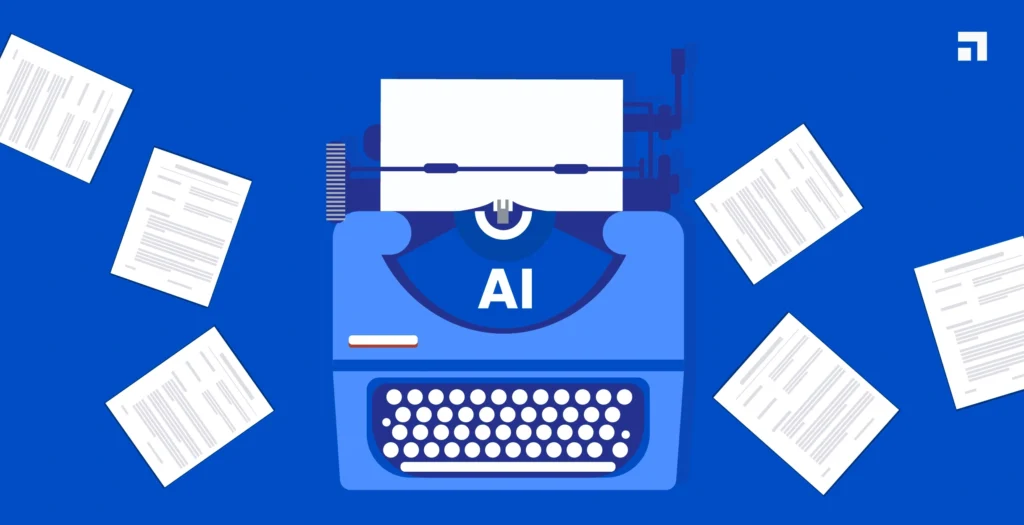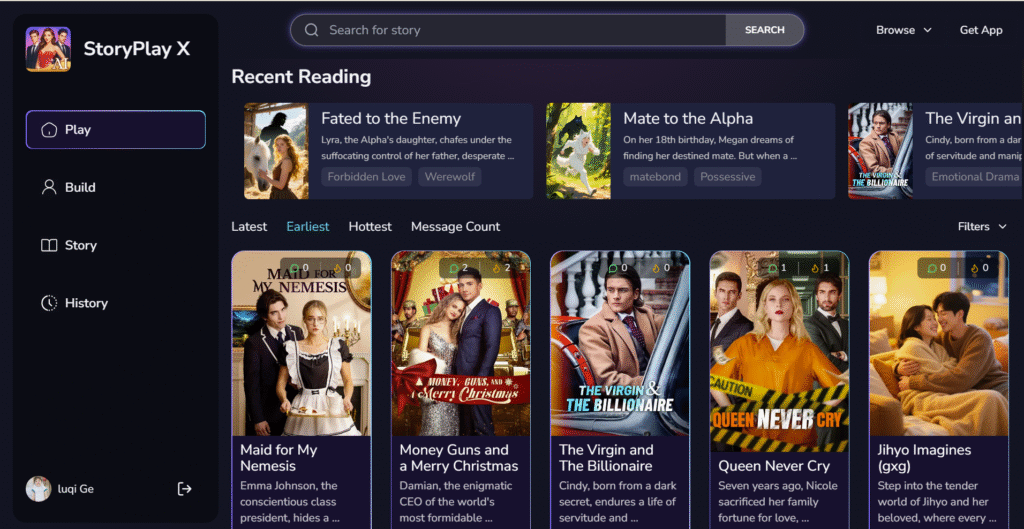Table of Contents
What if Shakespeare had an AI assistant to help craft his timeless tales? Would Hamlet’s soliloquy be even more profound? Would Romeo and Juliet’s tragedy unfold across multiple interactive paths? Today’s ai story maker technology isn’t about replacing the bard’s genius—it’s about unlocking the Shakespeare within every aspiring writer. From conquering writer’s block to transforming static narratives into immersive interactive experiences, artificial intelligence is revolutionizing how we create, share, and experience stories.
The blank page has terrorized writers for centuries. That cursor blinking on an empty document, mocking your creative ambitions. But the emergence of sophisticated ai story maker tools has fundamentally changed this dynamic. No longer do creators face their imagination alone—they have an intelligent collaborator ready to spark ideas, develop plots, and even transform finished stories into interactive adventures through platforms like StoryPlay X.

The Writer’s Eternal Struggles: How AI Story Makers Provide Solutions
Every writer knows the familiar enemies: writer’s block, plot holes, flat characters, and inconsistent world-building. Traditional solutions involved lengthy brainstorming sessions, expensive workshops, or simply pushing through the frustration. Modern ai story maker technology offers a revolutionary alternative—intelligent assistance that understands narrative structure and creative flow.
Writer’s block meets its match when AI can generate dozens of story beginnings from a single prompt. Stuck on how your protagonist escapes the burning building? Your ai story maker suggests ten plausible scenarios based on established character traits and story logic. Can’t figure out the murderer’s motive in your mystery novel? AI analyzes successful mystery structures and proposes motivations that fit your narrative.
Character development transforms from guesswork into guided creation. Advanced ai story maker platforms understand that compelling characters need consistent voices, believable motivations, and authentic dialogue. They analyze your character descriptions and suggest personality traits, speech patterns, and behavioral quirks that bring flat archetypes to life. The AI doesn’t create characters for you—it helps you discover the depths already implicit in your concepts.
World-building becomes manageable when artificial intelligence helps track the countless details that make fictional universes believable. Your ai story maker remembers that you established winter as the social season in Chapter 2, preventing contradictions when summer arrives in Chapter 10. It suggests cultural customs based on the geography you’ve created, proposes economic systems that match your political structures, and ensures technological consistency throughout your narrative.
The numbers speak volumes: studies show writers using ai story maker tools increase their output by an average of 70% while reporting higher satisfaction with their creative process. It’s not about writing faster—it’s about spending less time stuck and more time in creative flow.
AI Story Maker Technology Revolution: Beyond Simple Text Generation
Early AI writing tools functioned like sophisticated autocomplete—impressive but limited. Today’s ai story maker technology represents a quantum leap in capability. These systems understand narrative structure, character arcs, thematic development, and genre conventions. They’re less like typing assistants and more like knowledgeable writing partners who’ve read every book in the library.
Context awareness sets modern ai story maker platforms apart. When you write “Sarah entered the room,” the AI remembers Sarah’s previous appearances, her relationships with other characters, her current emotional state, and the significance of this particular room to your story. This deep contextual understanding enables suggestions that feel organic to your narrative rather than generic insertions.
Style learning allows ai story maker tools to adapt to individual voices. Feed it samples of your writing, and it learns your rhythm, vocabulary preferences, and narrative tendencies. Whether you write sparse, Hemingway-esque prose or lush, descriptive passages, the AI tailors its suggestions to match your unique voice. It’s like having an assistant who’s studied your entire body of work.
Genre intelligence means your ai story maker understands the unwritten rules of storytelling categories. Writing a romance? It knows readers expect certain emotional beats. Crafting a thriller? It suggests pacing that maintains tension. Building a fantasy world? It helps ensure your magic system follows consistent rules. This genre awareness prevents amateur mistakes while leaving room for creative rule-breaking.
StoryPlay X takes this technology further by seamlessly converting traditional narratives into interactive experiences. While other ai story maker platforms stop at text generation, StoryPlay X understands that modern audiences crave participation. Your linear novel becomes a branching adventure where readers shape the story through their choices.

5 Ways AI Story Makers Transform the Creative Process
1. Instant Outline Generation: From Concept to Structure
Give your ai story maker a simple premise—”A detective who can speak to ghosts solves murders”—and watch it generate comprehensive story structures. Within seconds, you receive multiple outline options: the classic three-act structure, the hero’s journey adaptation, or an experimental non-linear narrative. Each outline includes plot points, character arcs, and thematic threads, providing a roadmap that you can follow or diverge from as inspiration strikes.
2. Dynamic Character Dialogue: Authentic Voices for Every Personality
Creating distinct character voices challenges even experienced writers. Your ai story maker analyzes character profiles and generates dialogue that matches personality, education level, cultural background, and emotional state. The gruff military veteran speaks differently from the teenage social media influencer, and the AI maintains these distinctions throughout your narrative. Writers report that AI-assisted dialogue often sparks new character insights they hadn’t considered.
3. Atmospheric Scene Rendering: Sensory Details That Immerse
“The forest was dark” becomes “Ancient pines blocked the moonlight, their needle-carpeted floor muffling footsteps while somewhere in the darkness, an owl’s call echoed like a warning.” Modern ai story maker tools excel at expanding simple scene descriptions into immersive sensory experiences. They suggest sounds, smells, textures, and atmospheric details that make readers feel present in your fictional world.
4. Multi-Thread Plot Management: Keeping Complex Narratives Straight
Managing multiple plotlines challenges human memory, but your ai story maker tracks every thread with perfect recall. Writing an epic fantasy with fifteen viewpoint characters? The AI maintains timeline consistency, remembers who knows what information, and suggests when different plotlines should intersect for maximum impact. Visual plot mapping tools show how storylines weave together, preventing dropped threads or logical inconsistencies.
5. Interactive Transformation Magic: Static Stories Become Living Adventures
Here’s where StoryPlay X revolutionizes the ai story maker concept. Your completed story doesn’t end at “The End.” The platform’s StoryCard system identifies natural choice points in your narrative and transforms them into interactive moments. That scene where your protagonist faces a moral dilemma? Readers now make that choice themselves. The romantic tension between multiple characters? Readers guide relationship development. Your single story becomes dozens of possible adventures, all maintaining your original vision while allowing reader agency.
Real Case Study: From Idea to Interactive Novel in 24 Hours
Sarah Chen, a marketing professional with literary ambitions, demonstrates the power of modern ai story maker technology. Her concept: a time loop story where a wedding planner relives the same disastrous wedding until she discovers why the loop exists. Traditional writing methods might have taken months to develop this concept. With AI assistance and StoryPlay X, Sarah created a fully interactive novel in one day.
Hour 1-4: Sarah fed her premise to the ai story maker, which suggested five potential story structures. She chose a mystery framework with romantic subplot. The AI generated character profiles for the wedding planner protagonist, the mysterious bride and groom, suspicious family members, and wedding staff who might hold clues. Each character received distinct personalities, motivations, and secrets.
Hour 5-8: Using AI-assisted scene generation, Sarah wrote key moments: the wedding ceremony disaster, investigation scenes, and revelation moments. The ai story maker suggested sensory details that made each loop iteration feel unique—different weather, altered decorations, changing guest reactions. It maintained consistency while introducing subtle variations that built tension.
Hour 9-12: Sarah refined dialogue with AI assistance, ensuring each character’s voice remained distinct across multiple timeline iterations. The ai story maker caught continuity errors and suggested clues that felt organic rather than forced. By noon, she had a complete 5,000-word novella with satisfying mystery resolution.
Hour 13-16: This is where StoryPlay X transformed Sarah’s linear story into an interactive experience. The platform identified natural choice points: which suspect to investigate first, how to approach sensitive conversations, whether to reveal discovered information immediately or wait. Each choice branched into different investigative paths while maintaining the core mystery structure.
Hour 17-20: Sarah used StoryPlay X‘s variable system to track reader discoveries, ensuring the mystery remained solvable regardless of path taken. The ai story maker suggested three different endings based on player choices: justice-focused, romance-focused, or redemption-focused conclusions. Each felt authentic to the story world.
Hour 21-24: Final polish and testing. Sarah’s friends beta-tested the interactive story, discovering plot paths she hadn’t anticipated. The result: an interactive mystery with 15 meaningful choices, 3 distinct endings, and an 85% completion rate among test readers. Several testers played multiple times to explore different narrative branches.
“I never imagined I could create something this complex this quickly,” Sarah reflects. “The ai story maker didn’t write my story—it helped me discover the story I wanted to tell. And StoryPlay X let readers experience it in ways that made them feel like co-creators.”
StoryPlay X: Where AI Story Makers Meet Interactive Narrative
While many ai story maker platforms stop at text generation, StoryPlay X recognizes that modern storytelling demands more. The platform’s StoryCard system represents a paradigm shift in how we think about narrative creation and consumption. Import any story—whether AI-assisted or traditionally written—and transform it into an interactive experience that adapts to reader choices.
The three-perspective system offers unprecedented narrative flexibility. First-person mode immerses readers directly in the protagonist’s experience: “I reached for the door handle, my hand trembling.” Second-person creates that classic choose-your-own-adventure feel: “You stand before two paths, each promising different dangers.” Third-person provides cinematic distance: “Sarah weighed her options, unaware that her choice would reshape destiny.”
AI-enhanced branching goes beyond simple choose-A-or-B decisions. StoryPlay X‘s ai story maker analyzes your narrative to suggest meaningful choice points that reflect story themes. In a tale about redemption, choices might focus on forgiveness versus justice. In a romance, decisions could explore vulnerability versus self-protection. The AI ensures each branch feels authentic to your established story world.
Reader analytics provide invaluable feedback for creators. See which paths readers favor, where they abandon stories, which choices generate the most engagement. This data informs future creative decisions, helping writers understand what resonates with audiences. It’s like having a focus group for every story element, powered by actual reader behavior rather than hypothetical preferences.
Community features transform solitary writing into collaborative creation. Writers can invite others to contribute branches to their stories, with the ai story maker ensuring consistency across different authorial voices. Readers become co-creators, suggesting plot developments that authors can incorporate into expanded versions. StoryPlay X fosters a storytelling ecosystem where creation and consumption blur into participatory narrative art.
Creator’s Toolbox: Maximizing Your AI Story Maker’s Potential
Success with ai story maker technology requires understanding how to communicate with your AI collaborator. Prompt engineering—the art of crafting effective AI instructions—separates mediocre results from extraordinary assistance. Instead of “write a scary scene,” try “create a suspenseful moment in an abandoned hospital where the protagonist hears footsteps that match their own pace.” Specificity yields specificity.

Iterative refinement produces better results than expecting perfection immediately. Your first ai story maker output provides a foundation to build upon. Take what works, discard what doesn’t, and feed refined prompts back to the AI. Each iteration brings you closer to your vision while potentially revealing unexpected creative directions.
Training the AI to match your voice requires patience but pays enormous dividends. Feed your ai story maker samples of your best writing—passages that exemplify your style, tone, and rhythm. The more material it analyzes, the better it becomes at generating suggestions that feel authentically yours. Think of it as training a very intelligent apprentice who learns by example.
Quality control remains the human domain. Your ai story maker provides options, not obligations. Every suggestion requires evaluation against your creative vision. Does this plot development serve your themes? Does this dialogue sound like something your character would actually say? The AI handles the heavy lifting of generation, but artistic judgment remains irreplaceably human.
StoryPlay X integration streamlines the entire process. Write with AI assistance, transform into interactive format, and publish to eager readers—all within one platform. The seamless workflow means more time creating and less time managing technical details. Your ai story maker becomes part of a comprehensive creative ecosystem.
The Future of AI Story Makers: Democratizing Creativity
The trajectory of ai story maker technology points toward an unprecedented democratization of storytelling. Advanced natural language processing will soon understand not just what we write but what we intend to convey. Imagine AI that grasps subtext, irony, and emotional nuance as well as human readers—then helps weave these elements throughout your narrative.
Educational applications promise to revolutionize how we teach creative writing. Students can experiment with different styles, receive instant feedback, and understand narrative structure through hands-on experimentation. The ai story maker becomes a patient tutor, available 24/7, adapting to individual learning speeds and styles.
Commercial opportunities expand as interactive fiction gains mainstream acceptance. StoryPlay X creators already monetize their interactive stories, with top earners generating substantial income from engaged readerships. As ai story maker tools lower creation barriers, more diverse voices enter the marketplace, enriching our collective narrative landscape.
The convergence of AI generation and interactive presentation represents storytelling’s next evolution. We’re moving from passive consumption to active participation, from single narratives to infinite possibilities, from solitary creation to collaborative imagination. ai story maker technology doesn’t diminish the human element—it amplifies our capacity to share the stories burning within us.
Your story matters. Your voice deserves to be heard. Your imagination can touch lives across the globe. With modern ai story maker tools and platforms like StoryPlay X, the only limit is your willingness to begin. The blank page no longer mocks—it invites. The cursor no longer threatens—it beckons. The future of storytelling is collaborative, intelligent, and interactive. Most importantly, it includes you.
Start your journey today. Let AI amplify your creativity. Transform your stories into living worlds. Join the revolution that’s making every reader a potential writer and every writer a worldbuilder. The stories of tomorrow are being written today—with a little help from our artificial friends.
